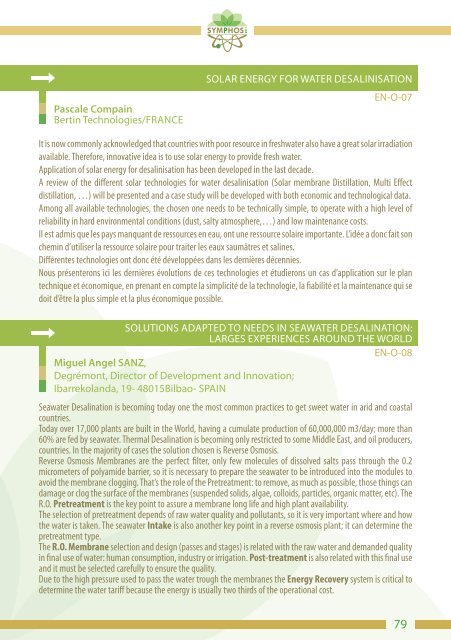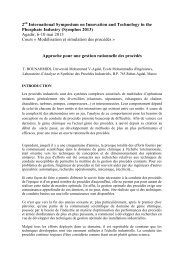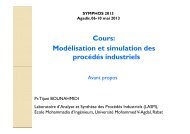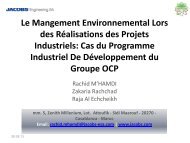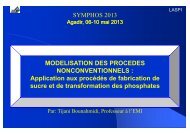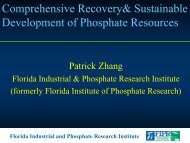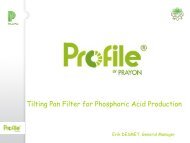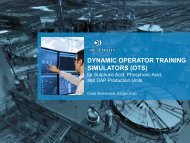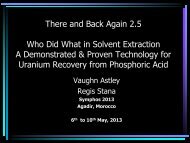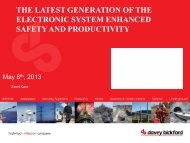Abstract SYMPHOS 2011
Abstract SYMPHOS 2011
Abstract SYMPHOS 2011
You also want an ePaper? Increase the reach of your titles
YUMPU automatically turns print PDFs into web optimized ePapers that Google loves.
Pascale Compain<br />
Bertin Technologies/FRANCE<br />
SOLAR ENERGY FOR WATER DESALINISATION<br />
EN-O-07<br />
It is now commonly acknowledged that countries with poor resource in freshwater also have a great solar irradiation<br />
available. Therefore, innovative idea is to use solar energy to provide fresh water.<br />
Application of solar energy for desalinisation has been developed in the last decade.<br />
A review of the different solar technologies for water desalinisation (Solar membrane Distillation, Multi Effect<br />
distillation, …) will be presented and a case study will be developed with both economic and technological data.<br />
Among all available technologies, the chosen one needs to be technically simple, to operate with a high level of<br />
reliability in hard environmental conditions (dust, salty atmosphere,…) and low maintenance costs.<br />
Il est admis que les pays manquant de ressources en eau, ont une ressource solaire importante. L’idée a donc fait son<br />
chemin d’utiliser la ressource solaire pour traiter les eaux saumâtres et salines.<br />
Différentes technologies ont donc été développées dans les dernières décennies.<br />
Nous présenterons ici les dernières évolutions de ces technologies et étudierons un cas d’application sur le plan<br />
technique et économique, en prenant en compte la simplicité de la technologie, la fiabilité et la maintenance qui se<br />
doit d’être la plus simple et la plus économique possible.<br />
SOLUTIONS ADAPTED TO NEEDS IN SEAWATER DESALINATION:<br />
LARGES EXPERIENCES AROUND THE WORLD<br />
Miguel Angel SANZ,<br />
Degrémont, Director of Development and Innovation;<br />
Ibarrekolanda, 19- 48015Bilbao- SPAIN<br />
EN-O-08<br />
Seawater Desalination is becoming today one the most common practices to get sweet water in arid and coastal<br />
countries.<br />
Today over 17,000 plants are built in the World, having a cumulate production of 60,000,000 m3/day; more than<br />
60% are fed by seawater. Thermal Desalination is becoming only restricted to some Middle East, and oil producers,<br />
countries. In the majority of cases the solution chosen is Reverse Osmosis.<br />
Reverse Osmosis Membranes are the perfect filter, only few molecules of dissolved salts pass through the 0.2<br />
micrometers of polyamide barrier, so it is necessary to prepare the seawater to be introduced into the modules to<br />
avoid the membrane clogging. That’s the role of the Pretreatment: to remove, as much as possible, those things can<br />
damage or clog the surface of the membranes (suspended solids, algae, colloids, particles, organic matter, etc). The<br />
R.O. Pretreatment is the key point to assure a membrane long life and high plant availability.<br />
The selection of pretreatment depends of raw water quality and pollutants, so it is very important where and how<br />
the water is taken. The seawater Intake is also another key point in a reverse osmosis plant; it can determine the<br />
pretreatment type.<br />
The R.O. Membrane selection and design (passes and stages) is related with the raw water and demanded quality<br />
in final use of water: human consumption, industry or irrigation. Post-treatment is also related with this final use<br />
and it must be selected carefully to ensure the quality.<br />
Due to the high pressure used to pass the water trough the membranes the Energy Recovery system is critical to<br />
determine the water tariff because the energy is usually two thirds of the operational cost.<br />
79


